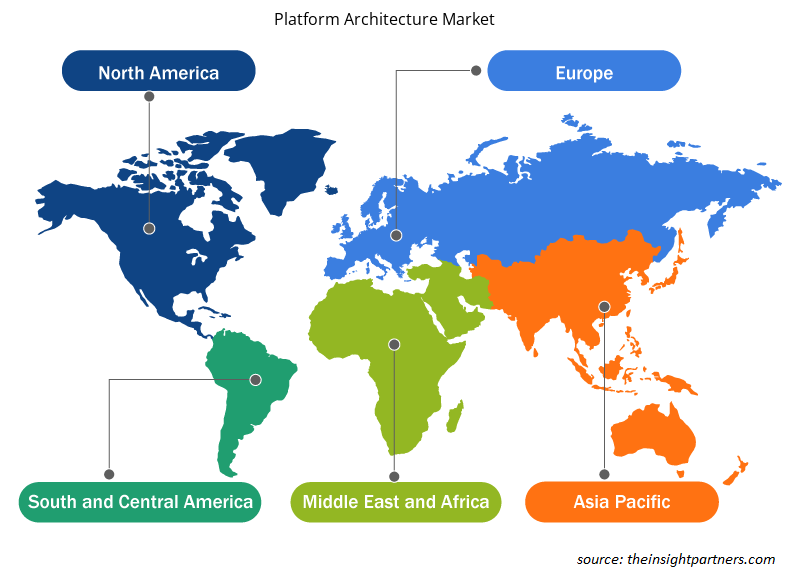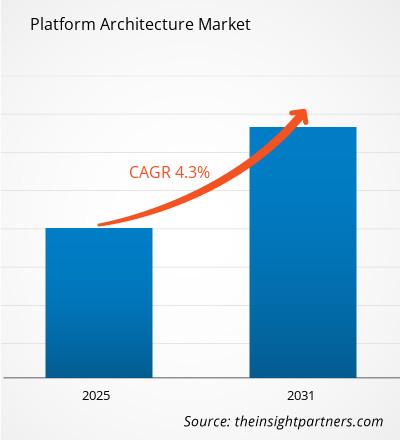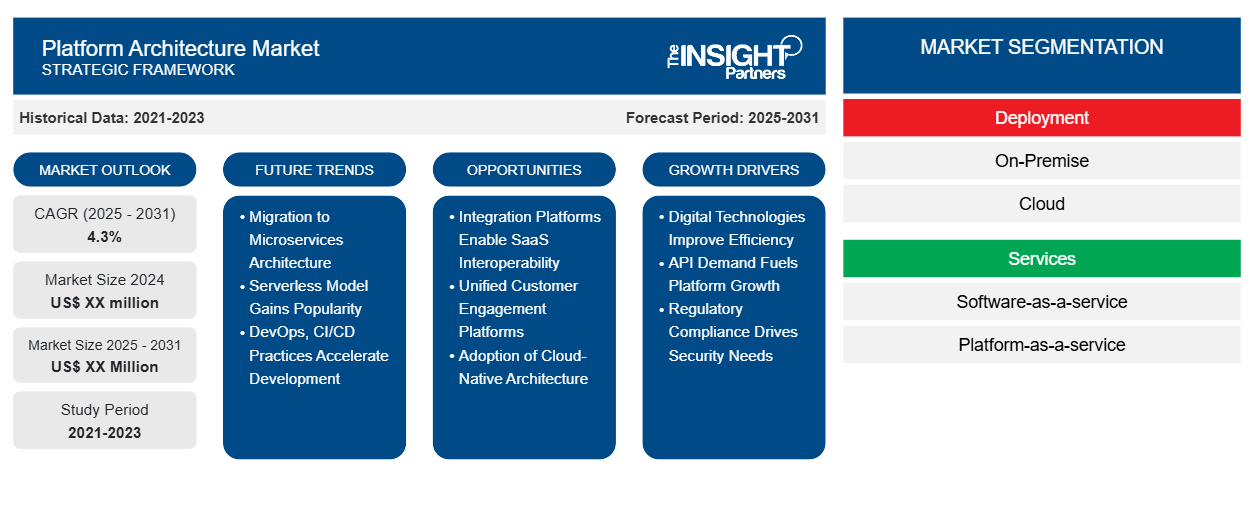플랫폼 아키텍처 시장은 2023년부터 2031년까지 4.3%의 CAGR을 기록할 것으로 예상되며, 시장 규모는 2023년의 XX백만 달러에서 2031년 XX백만 달러로 확대될 것으로 예상됩니다.
플랫폼 아키텍처 시장 보고서는 배포, 서비스, 최종 사용자 및 지리적 영역별 분석을 다룹니다. 글로벌 분석은 지역 수준과 주요 국가별로 더 세분화됩니다.
보고서의 목적
The Insight Partners의 플랫폼 아키텍처 시장 보고서는 현재의 상황과 미래 성장, 주요 추진 요인, 과제, 기회를 설명하는 것을 목표로 합니다. 이를 통해 다음과 같은 다양한 비즈니스 이해 관계자에게 통찰력을 제공합니다.
- 기술 제공업체/제조업체: 변화하는 시장 역학을 이해하고 잠재적인 성장 기회를 파악하여 정보에 입각한 전략적 결정을 내릴 수 있도록 합니다.
- 투자자: 시장 성장률, 시장 재무 전망, 가치 사슬 전반에 존재하는 기회에 대한 포괄적인 추세 분석을 수행합니다.
- 규제 기관: 시장의 정책과 경찰 활동을 규제하여 남용을 최소화하고, 투자자의 신뢰와 확신을 유지하며, 시장의 성실성과 안정성을 뒷받침합니다.
플랫폼 아키텍처 시장 세분화
전개
- 온프레미스
- 구름
서비스
- 소프트웨어 즉 서비스
- 플랫폼으로서의 서비스
최종 사용자
- 증권거래위원회
- 정부
- IT 및 통신
- 조작
- 소매
- 기타
지리학
- 북아메리카
- 유럽
- 아시아 태평양
- 남미 및 중미
- 중동 및 아프리카
지리학
- 북아메리카
- 유럽
- 아시아 태평양
- 남미 및 중미
- 중동 및 아프리카
귀하의 요구 사항에 맞게 이 보고서를 사용자 정의하세요
이 보고서의 일부 또는 국가 수준 분석, Excel 데이터 팩을 포함하여 모든 보고서에 대한 사용자 정의를 무료로 받을 수 있으며 신생 기업 및 대학을 위한 훌륭한 혜택과 할인 혜택을 이용할 수 있습니다.
- 이 보고서의 주요 시장 동향을 알아보세요.이 무료 샘플에는 시장 동향부터 추정 및 예측까지 다양한 데이터 분석이 포함됩니다.
플랫폼 아키텍처 시장 성장 동인
- 디지털 기술은 효율성을 개선합니다. 많은 기업이 디지털 기술을 사용하여 효율성과 사용자 경험을 개선하고 있습니다. 플랫폼 아키텍처는 여러 디지털 솔루션을 연결하여 보다 효과적으로 상호 작용합니다. 데이터를 더 잘 교환할 수 있고 운영 민첩성이 향상되기 때문에 많은 조직이 플랫폼 아키텍처로 전환하여 더 낮은 비용으로 더 많은 비즈니스를 수행하고 신제품과 서비스의 출시 시간을 단축하고 있습니다. 따라서 견고한 플랫폼 아키텍처에 대한 수요는 조직의 프로세스 간소화, 더 나은 의사 결정, 새로운 솔루션 공동 개발 필요성으로 인해 발생합니다.
- API 수요는 플랫폼 성장을 촉진합니다. 애플리케이션 프로그래밍 인터페이스(API)에 대한 수요가 증가함에 따라 더 많은 회사가 애플리케이션과 서비스를 상호 운용 가능하게 만들거나 API를 통해 외부 소스에서 두 가지를 보다 효과적으로 통합하려고 노력함에 따라 이러한 추세가 촉진되고 있습니다(API는 한 애플리케이션과 다른 애플리케이션 간의 인터페이스로, 서로 더 잘 통신할 수 있으므로 훨씬 더 나은 사용자 경험과 운영 효율성을 제공합니다). 게다가 회사가 마이크로서비스 아키텍처와 애자일 개발 방법론을 채택함에 따라 훨씬 더 정교한 API 관리 정책과 시스템도 필요합니다. 그 결과, 더 많은 회사가 API를 사용하여 확장 가능한 방식으로 제품과 솔루션을 구축함에 따라 플랫폼 아키텍처가 더욱 확산되고 있습니다.
- 규정 준수는 보안 요구 사항을 촉진합니다. 규정은 다가오는 입법안마다 엄격해집니다. 따라서 신세대 기업은 시장의 보안 요구 사항과 규정을 준수하도록 플랫폼 아키텍처를 구축하고 있습니다. 이를 위해서는 견고한 보안 메커니즘, ID 관리, 액세스 관리 및 데이터 거버넌스와 같은 플랫폼 아키텍처의 보안 기능에 더 많이 투자해야 합니다. 시장에서 엄격한 규제 요구 사항이 등장함에 따라 채널 고객은 엄격한 보안 태세를 확립하고 규정 준수 요구 사항을 충족해야 합니다. 변화하는 규제 환경에서 기업은 보안 태세를 강화하고 규정 준수를 지원하기 위해 점점 더 플랫폼 제공이 필요하게 될 것이며, 이는 시장 성장에 영향을 미칩니다.
플랫폼 아키텍처 시장 미래 동향
- 마이크로서비스 아키텍처로의 마이그레이션: 기업은 모놀리식 시스템에서 벗어나 마이크로서비스 아키텍처로 마이그레이션하고 있습니다. 효율적이고 독립적으로 확장하는 데 도움이 되고, 유연성과 속도를 개선할 수 있으며, 팀이 배포 또는 확장을 위해 항상 중앙 명령을 거칠 필요가 없습니다. 대신 스스로 할 수 있습니다. 따라서 리소스를 보다 효율적으로 사용하고, 다양한 기술을 통합하고, 오늘날의 경쟁적인 디지털 환경에서 지속적인 혁신을 지원하는 기능의 이점을 누릴 수 있습니다. 다시 말해, 클라우드 네이티브 기술이 성숙해짐에 따라 마이크로서비스가 현대 애플리케이션의 표준이 될 것입니다.
- 서버리스 모델이 인기를 얻다: 코더가 서버를 관리하지 않고 앱을 작성하는 떠오르는 서버리스 모델이 이미 인기를 얻고 있습니다. 부하에 따라 자동으로 애플리케이션을 확장하면 물리적 또는 가상 관리 서버보다 리소스를 더 잘 활용할 수 있으며 비용 효율성이 향상될 수 있습니다. 실제로 모든 규모의 회사는 최근 분석 엔터프라이즈 데이터베이스 또는 전체 이벤트 기반 애플리케이션과 같은 서버리스 워크로드를 전환하여 더 빠른 사이클 타임의 이점을 얻고 기존 인프라 관리 오버헤드를 줄였습니다. 클라우드 서비스 제공업체가 서버리스 포트폴리오를 개선하고 이 모델로 워크로드를 마이그레이션하는 데 더 많은 도움을 제공함에 따라 이러한 추세가 가속화될 것으로 예상합니다. 전반적으로 이 서버리스 추세는 엔터프라이즈 스택 전체에서 실험 및 개발을 위한 속도와 리소스 활용도를 개선할 것입니다.
- DevOps, CI/CD 관행은 개발을 가속화합니다. DevOps는 지속적인 통합/지속적인 배포(CI/CD) 관행과 Agile 개발 방법론의 광범위한 채택을 결합하여 개발자와 운영자 간의 갈등과 핸드오프를 최소화하는 플랫폼 아키텍처의 변화를 반영하는 포괄적인 용어로 등장했습니다.
테스트와 배포가 자동화되면 오류가 한 단계에서 다른 단계로 넘어갈 가능성이 줄어들어 더 나은 품질의 소프트웨어가 더 빠르게 제공됩니다. 더 많은 회사가 Agile 방법론을 채택할수록 DevOps 및 CI/CD 관행이 전면에 나서 고객에게 기능 제공 속도가 향상될 수 있습니다.
플랫폼 아키텍처 시장 기회
- 통합 플랫폼은 SaaS 상호 운용성을 가능하게 합니다. 점점 더 많은 SaaS 애플리케이션을 사용하는 고객은 데이터가 서로 다른 애플리케이션 간에 유연하게 통신할 수 있도록 미들웨어 또는 통합 플랫폼이 필요합니다. 기업은 더 많은 애플리케이션이나 서비스를 개발할 필요가 없으며, 서로 다른 SaaS 애플리케이션 간의 원활한 데이터 교환과 상호 운용성만 있으면 됩니다.
- 통합 고객 참여 플랫폼: 특히 디지털로 전환했지만 고객 및 최종 사용자 경험을 개선하거나 차별화하고 싶어하는 기업의 통합 고객 참여에 대한 수요가 증가함에 따라 비즈니스 콘텐츠 관리, 분석, 웹 및 모바일 사용자 경험, 참여 지점을 결합하는 아키텍처를 제공하는 디지털 경험 플랫폼 공급업체에게 기회가 창출되고 있습니다.
- 클라우드 네이티브 아키텍처 채택: 플랫폼 아키텍처 시장에서 가장 중요한 기회 중 하나는 클라우드 네이티브 아키텍처입니다. 더 낮은 비용으로 더 큰 확장성과 유연성을 제공하는 클라우드로의 대부분 기업의 전환은 클라우드 환경을 위한 최적화된 플랫폼 아키텍처에 대한 수요 증가로 이어지고 있습니다. 마이크로서비스, 컨테이너 및 API를 기반으로 구축된 클라우드 네이티브 플랫폼을 통해 기업은 기존의 모놀리식 아키텍처보다 더 빠르고 비용 효율적으로 애플리케이션과 서비스를 개발할 수 있습니다. 이러한 전환의 핵심 동인은 개발 및 배포의 민첩성과 수요에 따른 리소스 확장입니다. 플랫폼 아키텍처 제공자의 관점에서 볼 때 이러한 추세는 기업의 디지털 전환을 지원하는 솔루션을 제공할 수 있는 엄청난 기회를 만들어냅니다. 클라우드 네이티브 플랫폼이 제공하는 또 다른 이점은 더 나은 재해 복구, 자동 확장 및 더 나은 성능 모니터링을 포함한 보다 안정적인 환경입니다. 따라서 상승 추세는 기업이 디지털 우선 전략을 채택하고 클라우드 네이티브 플랫폼 아키텍처 솔루션의 구현을 요구하며 혁신과 시장 성장으로의 새로운 문을 제공하는 방향으로 일관되게 유지될 것입니다.
플랫폼 아키텍처 시장 지역 통찰력
Insight Partners의 분석가들은 예측 기간 동안 플랫폼 아키텍처 시장에 영향을 미치는 지역적 추세와 요인을 철저히 설명했습니다. 이 섹션에서는 북미, 유럽, 아시아 태평양, 중동 및 아프리카, 남미 및 중미의 플랫폼 아키텍처 시장 세그먼트와 지리적 분포도 논의합니다.

- 플랫폼 아키텍처 시장에 대한 지역별 데이터 얻기
플랫폼 아키텍처 시장 보고서 범위
| 보고서 속성 | 세부 |
|---|---|
| 2023년 시장 규모 | 미화 XX백만 달러 |
| 2031년까지 시장 규모 | 미화 XX 백만 |
| 글로벌 CAGR (2023-2031) | 4.3% |
| 역사적 데이터 | 2021-2022 |
| 예측 기간 | 2024-2031 |
| 다루는 세그먼트 | 배치에 의해
|
| 포함된 지역 및 국가 | 북아메리카
|
| 시장 선도 기업 및 주요 회사 프로필 |
|
플랫폼 아키텍처 시장 참여자 밀도: 비즈니스 역학에 미치는 영향 이해
플랫폼 아키텍처 시장 시장은 소비자 선호도의 변화, 기술 발전, 제품의 이점에 대한 인식 증가와 같은 요인으로 인해 최종 사용자 수요가 증가함에 따라 빠르게 성장하고 있습니다. 수요가 증가함에 따라 기업은 제품을 확장하고, 소비자의 요구를 충족하기 위해 혁신하고, 새로운 트렌드를 활용하여 시장 성장을 더욱 촉진하고 있습니다.
시장 참여자 밀도는 특정 시장이나 산업 내에서 운영되는 회사나 기업의 분포를 말합니다. 주어진 시장 공간에 얼마나 많은 경쟁자(시장 참여자)가 존재하는지 그 규모나 전체 시장 가치에 비해 나타냅니다.
플랫폼 아키텍처 시장에서 운영되는 주요 회사는 다음과 같습니다.
- 주식회사 아프렌다
- 아마존 웹 서비스
- 시스코 시스템즈 주식회사
- 구글 유한회사
- IBM 주식회사
면책 조항 : 위에 나열된 회사는 어떤 특별한 순서에 따라 순위가 매겨지지 않았습니다.

- 플랫폼 아키텍처 시장 주요 주요 업체 개요를 알아보세요
주요 판매 포인트
- 종합적 범위: 이 보고서는 플랫폼 아키텍처 시장의 제품, 서비스, 유형, 최종 사용자에 대한 분석을 종합적으로 다루어 전체적인 상황을 제공합니다.
- 전문가 분석: 이 보고서는 업계 전문가와 분석가의 심층적인 이해를 바탕으로 작성되었습니다.
- 최신 정보: 이 보고서는 최신 정보와 데이터 동향을 다루고 있어 비즈니스 관련성을 보장합니다.
- 사용자 정의 옵션: 이 보고서는 특정 고객 요구 사항에 맞게 사용자 정의할 수 있으며 비즈니스 전략에 적합하게 조정할 수 있습니다.
따라서 플랫폼 아키텍처 시장에 대한 연구 보고서는 산업 시나리오와 성장 전망을 디코딩하고 이해하는 길을 선도하는 데 도움이 될 수 있습니다. 몇 가지 타당한 우려가 있을 수 있지만 이 보고서의 전반적인 이점은 단점보다 더 큰 경향이 있습니다.
- 과거 분석(2년), 기준 연도, CAGR을 포함한 예측(7년)
- PEST 및 SWOT 분석
- 시장 규모 가치/거래량 - 글로벌, 지역, 국가
- 산업 및 경쟁 환경
- Excel 데이터세트
최근 보고서
사용 후기
구매 이유
- 정보에 기반한 의사 결정
- 시장 역학 이해
- 경쟁 분석
- 고객 인사이트
- 시장 예측
- 위험 완화
- 전략 기획
- 투자 타당성 분석
- 신흥 시장 파악
- 마케팅 전략 강화
- 운영 효율성 향상
- 규제 동향에 발맞춰 대응





















 무료 샘플 받기 - 플랫폼 아키텍처 시장
무료 샘플 받기 - 플랫폼 아키텍처 시장